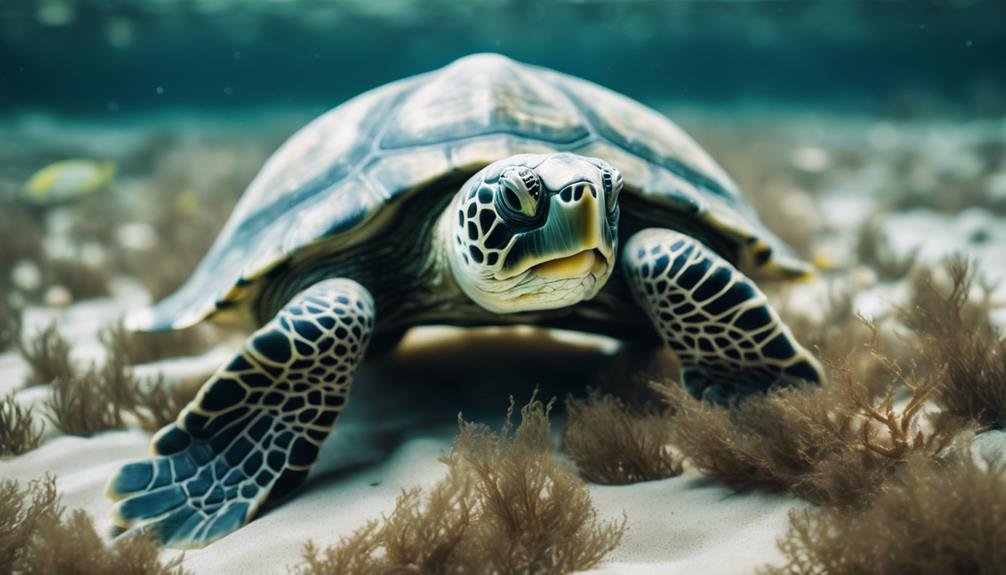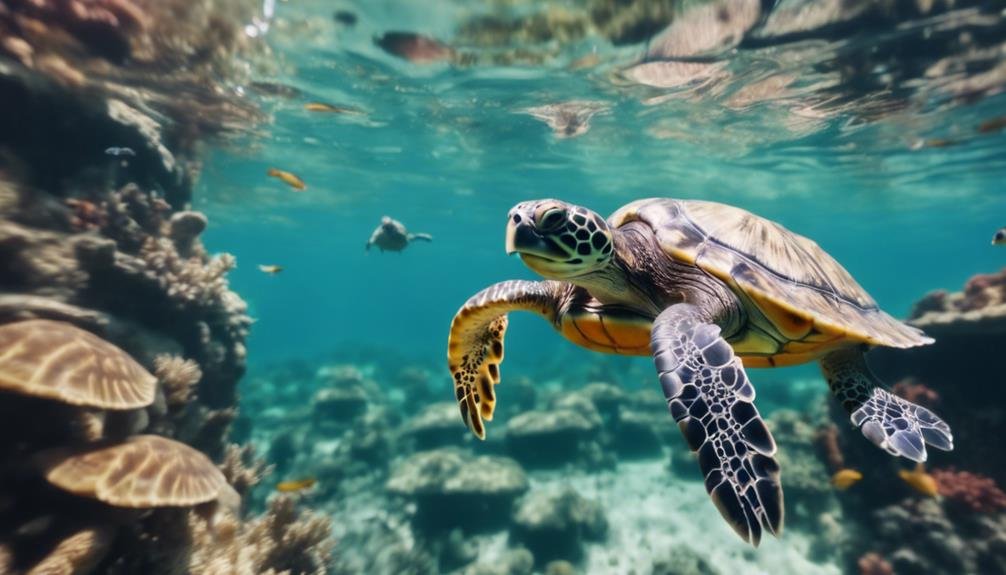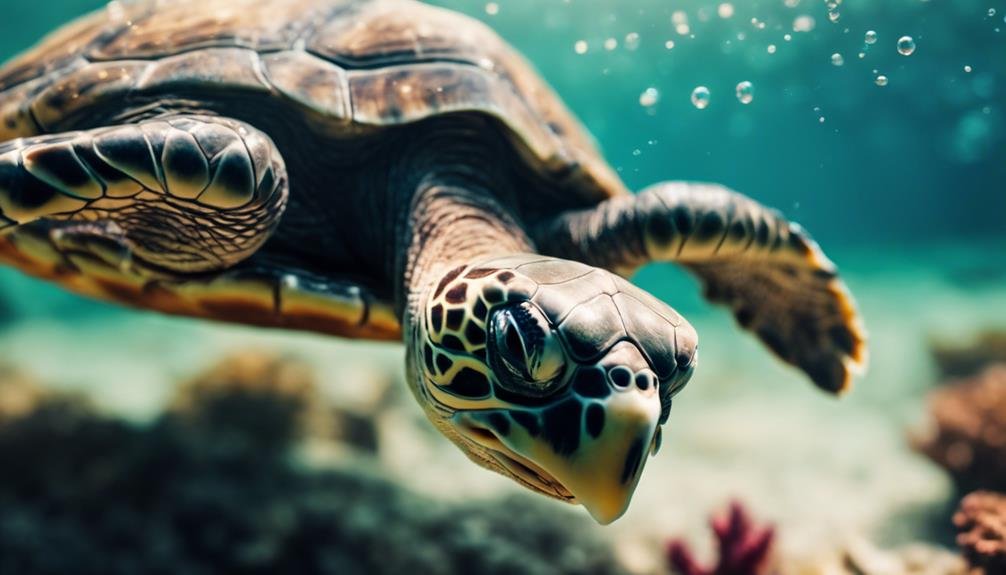Have you ever pondered how long turtles can hold their breath underwater? It’s quite fascinating to contemplate that these creatures can immerse themselves for hours, some species up to seven, thanks to unique physiological adaptations. Factors such as age, health, and environment play significant roles in determining their breath-holding capacity. What’s intriguing is how these factors interplay to either enhance or limit a turtle’s ability to stay submerged. As you think about the resilience and survival tactics of turtles, you might find yourself curious about the specific adaptations that allow such feats and how they vary across different turtle species.
Key Takeaways
- Sea turtles can hold their breath for up to 7 hours while resting.
- Breath-holding capacity varies by species, age, size, and health.
- Environmental factors like water temperature and oxygen levels also influence breath duration.
- Turtles can extend breath-holding by slowing their heart rate to conserve oxygen.
- Stress or active movement reduces breath-holding time, requiring more frequent surfacing.
Turtles’ Breath-Holding Capabilities
Sea turtles can hold their breath for up to 7 hours while resting, showcasing remarkable adaptations to their aquatic environments. These incredible breath-holding capacities vary among species, such as the green turtles, and are essential for their survival in diverse marine ecosystems. When you delve into the details, you’ll notice that their ability to stay underwater for extended periods isn’t just about lung capacity but also involves their overall activity levels.
During migration, sea turtles demonstrate extraordinary submersion durations. This ability allows them to travel long distances across oceans without frequent surfacing, which is vital for energy conservation and predator avoidance. The migration journey is a tribute to their resilience and an integral part of marine ecology, reflecting how these creatures have evolved to master their underwater world.
Moreover, in colder months, some sea turtles enter a state akin to hibernation, where their metabolic rate drops, and they can remain submerged for considerably longer durations without the need to breathe. This adaptation ensures they can withstand harsher environments and seasonal food shortages, making them incredible survivors of the marine world.
Factors Affecting Breath Duration
Understanding the factors that influence how long turtles can hold their breath is key to appreciating their survival adaptations. The breath-holding capacity of turtles isn’t just an innate skill; it’s shaped by several variables including species, age, size, and health status. For instance, larger and mature turtles generally outperform their younger or smaller counterparts in breath-holding, mainly due to their developed lungs and greater overall resilience.
Environmental factors play a vital role as well. Water temperature and oxygen levels in their marine habitat directly impact how long turtles can sustain themselves without surfacing for air. Colder waters might slow down their metabolism, allowing them to conserve oxygen and stay submerged longer.
Additionally, the presence of predators and the availability of prey are essential. Turtles have adapted to modify their breath-holding times based on these external threats and opportunities. If predators are nearby, a turtle might stay underwater longer to avoid detection. Conversely, when prey is abundant, they might frequently surface to maximize their hunting success.
All these elements—ranging from biological to environmental—interact to define the breath-holding capabilities of turtles, illustrating a complex adaptation essential for thriving in their aquatic world.
Adaptations for Oxygen Conservation


Turtles have developed remarkable adaptations to conserve oxygen, allowing them to remain underwater for extended periods. When sea turtles hold their breath, they can greatly slow down their heart rate. This heart rate regulation is important for oxygen conservation, reducing oxygen depletion and enabling green turtles to enjoy the deep without frequent surfacing.
In moments of calm, sea turtles demonstrate incredible breath-holding adaptations, staying submerged for hours. This ability hinges on their capacity to manage oxygen use meticulously when resting. However, when faced with predators or other stressors, their stress response can quickly use up oxygen reserves, necessitating rapid surfacing behavior to replenish and avoid suffocation.
Below is a table summarizing key adaptations and their functions:
| Adaptation | Function |
|---|---|
| Heart rate regulation | Reduces oxygen use, extends dive time |
| Breath-holding adaptations | Allows long periods underwater |
| Rapid surfacing | Replenishes oxygen, prevents suffocation |
These adaptations not only enhance survival but also illustrate the sophisticated natural engineering of sea turtles, enabling them to thrive in aquatic environments. Remember, while these adaptations are impressive, stressful situations can still pose serious risks.
Diving Behaviors in Turtles
Diving behaviors vary among turtles based on their activity levels, whether they’re foraging, migrating, or resting. When you look at green turtles, their dive behavior reflects this variation distinctly. During foraging, these turtles can’t hold their breath for long; they frequently surface to breathe as they actively search for food. In contrast, during migration, especially oceanic migrations that require long distances, green turtles demonstrate remarkable breath-holding capabilities.
The conservation of oxygen is important here. Turtles regulate their blood flow to make sure that vital organs receive enough oxygen while non-essential systems are temporarily minimized. This adaptation is particularly evident during hibernation. Dive durations extend dramatically as turtles enter a state of reduced metabolic activity, allowing them to conserve energy and oxygen.
Understanding these patterns is essential for conservation efforts. By recognizing how activity levels affect breath holding and dive durations, you can better appreciate the challenges turtles face during different phases of their life cycle, such as migration and hibernation. This knowledge helps in crafting strategies that protect their natural behaviors while considering the environmental pressures they encounter.
Does a Turtle’s Ability to Hold its Breath Affect Tank Water Cleanliness?
Yes, a turtle’s ability to hold its breath can affect the cleanliness of the tank water. Turtles release waste and produce ammonia, which can make the water dirty. Proper filtration and water changes are necessary for keeping turtle tank water clean.
Environmental Impact on Breath-Holding


While environmental conditions like water temperature and prey availability significantly influence how long sea turtles can hold their breath, other factors also play a role. You need to take into account how green turtles, among other species, adjust their breathing patterns and dive durations in response to these environmental factors. It’s not just about the cold or the warmth of the water but also about what’s happening around them.
For instance, if predators are nearby, sea turtles may alter their usual behavior, diving deeper or shorter than usual, which can affect their breath-holding capabilities. The presence of predators isn’t just a momentary challenge; it’s a significant factor that can dictate the physiological condition of these turtles. Young or unhealthy turtles, in particular, might find themselves at a disadvantage, having shorter breath-holding spans due to less robust health.
Moreover, sea turtles’ remarkable adaptability allows them to thrive in diverse marine environments. This adaptability reflects in their ability to modify dive durations and breathing patterns, effectively responding to the changing conditions around them. Whether it’s evading a predator or searching for food, sea turtles showcase an impressive capacity to manage their breath-holding to survive and flourish.
Conclusion
As you explore the world of sea turtles, you’ll find their breath-holding abilities quite remarkable. Factors like age, size, and health play important roles, as do water temperature and oxygen levels.
Their adaptations, such as slowing heart rates, are essential for survival in diverse marine environments. By understanding these capabilities and the challenges turtles face, you’re better equipped to appreciate and support conservation efforts that help protect these incredible creatures and their natural habitats.


